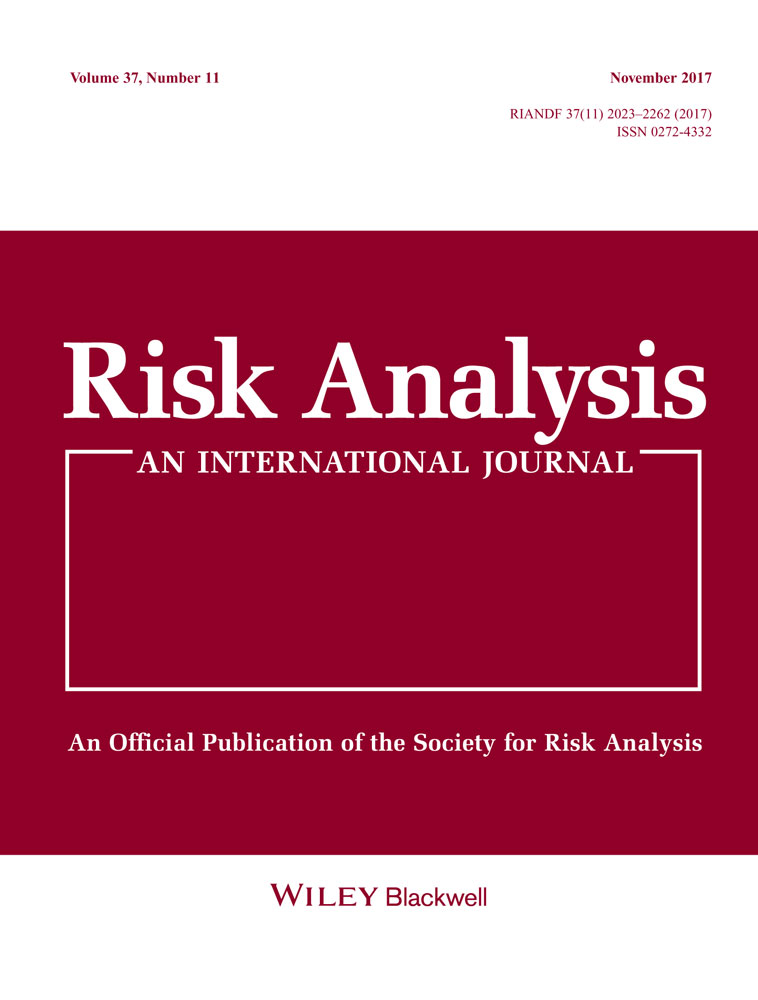The Precautionary Principle Has Not Been Shown to Be Incoherent: A Reply to Peterson
Abstract
In this journal, I have objected to Peterson's 2006 claim that the precautionary principle is an incoherent decision rule. I defend my objections to Peterson's recent replies, and I still claim that the precautionary principle has not been shown to be incoherent.
1. INTRODUCTION
In an article published in this journal,1 I raised three objections to Martin Peterson's claim2 that the precautionary principle (hereafter PP) is an incoherent decision rule. He replied to my objections in Ref. 3 and maintained his conclusions. I reply here by considering each objection in turn.
2. FIRST OBJECTION
I argued that “three premises of Peterson's theorem require the decisionmaker to know the state space of the decision problem,” whereas interesting cases of PP are those in which the state space is not known. Peterson replies that “the theorem is not based on any assumption whatsoever about what the decisionmaker knows,” but only on “the assumption that the likelihood and desirability of each outcome can be ranked on some ordinal scale,” typically if one “were to receive some additional information.”3
I agree with Peterson that it makes sense to assume that likelihoods can be ranked on some ordinal scale when receiving more information. The only limitation concerns desirabilities: because of incommensurability issues (cf. my second objection in Ref. 1), some outcomes may be incomparable even if one receives more information. This shows that the scope of Peterson's theorem is limited to outcomes that are, in principle, comparable.
3. SECOND OBJECTION
My second objection concerns the Archimedean condition, which is one of the key premises in Peterson's theorem. Peterson does not challenge the first part of my objection. He is, as far as I can understand, endorsing it when he acknowledges that “the key intuition behind the Archimedean condition is at odds with the precautionary principle.”3 As I argued,1 this entails that no sensible decisionmaker can stick to both premises (the Archimedean condition and PP), as they express conflicting views.
Let me clarify this. The Archimedean condition makes sense in cost–benefit analysis. However, PP is supposed to compete with or replace cost–benefit analysis for some range of problems.4-6 So of course, someone who accepts PP needs not accept the Archimedean condition. Hence, Peterson's theorem cannot be used to say to someone who accepts PP, “you shouldn't, because you're being incoherent.” The person is just being inconsistent with something she does not adhere to—so what?
Instead, Peterson's theorem should (only) be interpreted in the following way: it formally shows that, given two other technical premises, the Archimedian condition and (as I argue in my third objection, an inadequate explication of) PP are in conflict. In other words, Peterson's theorem shows that PP departs from cost–benefit analysis in that it considers some outcomes to be so bad that they cannot be compensated by possible benefits (in the specific form of the Archimedean condition).
So, Peterson's theorem is not in itself an argument against PP. It becomes one only when one accepts the Archimedian condition. But should one? I believe this question is not about being rational or reasonable, as Peterson writes in his 2006 paper, but a question about how one values different kinds of outcomes.
When answering the second part of my objection, Peterson suggests an escape route: change the scope of the theorem so that it applies to incommensurable outcomes. I doubt this can be done—not only does the Archimedean condition need a reformulation, but also the total order condition. Furthermore, my third objection would still apply to an incommensurable version of the theorem.
4. THIRD OBJECTION
I argued that Peterson's explication of the PP is inadequate, and I gave an example in which the decision it recommends depends on the formulation of the decision problem. Peterson does not think this is necessarily a drawback, and he refers to some such cases in traditional decision theory.7
I find this move problematic. I interpret the case of the principle of insufficient reason that Peterson gives as an example in his textbook (“if there is no reason to believe that one state of the world is more probable than another then ... every state [should be] assigned equal probability” [Ref. 7, p. 33]) the other way round: it is well known to be problematic unless a firm criterion to define states is given. This relates with one of the points I raised, and to which Peterson has not answered: “if one wanted to claim that only some formulations of the case should be considered when applying PPδ, then one should specify (i) which ones, and most importantly (ii) why.”1 Peterson writes in his reply that the formulation in my Table III is “better” than the one in Table II, but he does not say why.1 One might suggest that it is better because identical states (in my example,  ) should be merged. But as already indicated in Ref. 1, my counterexample can be generalized to nonidentical states. Then, it is unclear which nonidentical states should be merged, and why. Until a general defense of why some formulations are better than others is provided in the case of PP, Peterson's explication should be suspect.
) should be merged. But as already indicated in Ref. 1, my counterexample can be generalized to nonidentical states. Then, it is unclear which nonidentical states should be merged, and why. Until a general defense of why some formulations are better than others is provided in the case of PP, Peterson's explication should be suspect.
5. CONCLUSION
I conclude that my second and third objections are valid. Peterson's theorem cannot be used to curse proponents of PP for being incoherent. A better interpretation of the theorem is that it clarifies where PP departs from traditional decision theory.




